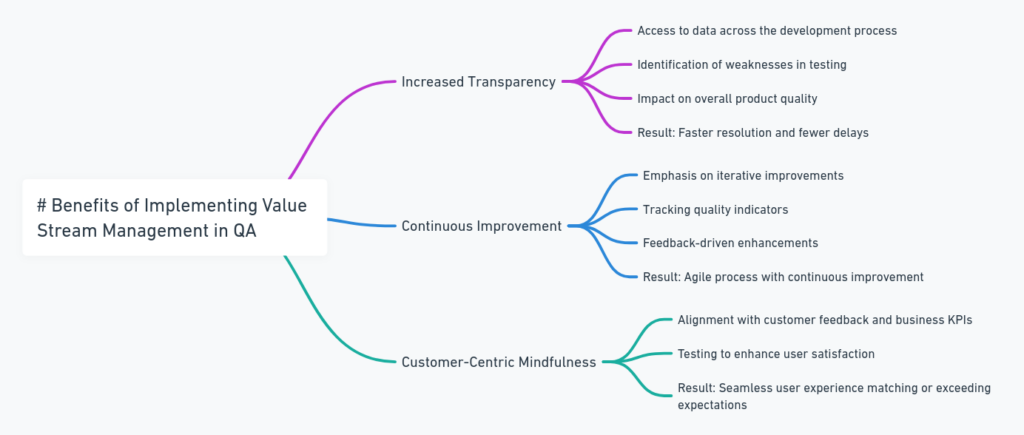In today's fast-paced world that is software development ensuring that the product is of high quality isn't just about ensuring that the code is tested; it's about providing products that satisfy the requirements of customers and their goals.
This is the point where Value Stream Management is a key component. By focusing on the entire cycle of value, from the initial idea through delivery to customers, VSM transforms quality assurance (QA) into an effective tool to optimize business results.
What is Value Stream Management?
Value Stream Management (VSM) is the process of analyzing, monitoring and enhancing efficiency of the value stream across the lifecycle of software development (SDLC).
The objective is to ensure that both development and QA efforts with business goals and assure that every step of the process provides value to the end-user as well as the company.
Key Aspects of Value Stream Management:
- Visibility provides a concise outline of software distribution pipeline.
- Optimization It identifies and eliminates the bottlenecks in processes.
- Alignment Linking the development process to the business objectives and the needs of customers.
Results:
Focusing on value delivery, businesses can assure that they're not just building the right software but also building the correct software.
Elevating QA from Technical Validation to Business Value
Traditional QA practices typically focus on the detection of defects and validation of technical aspects, which although essential, might not reflect the full picture.
Value Stream Management improves QA by making sure that testing efforts are directly related to the creation in terms of value for business.
How Value Stream Management Transforms QA:
- Shift-Left Testing Using Focus on Business attention: VSM encourages teams to start testing earlier during the development process however, with a focus on the business and customer impact. This proactive approach helps avoid issues that may cause problems with the delivery of value.
- Final Quality Assurance: Teams of QA are able to track quality metrics across the entire value stream starting with the initial design and ending with deployment, and prepare actionable insight for continual improvement.
- Feedback loops: The real-time information taken from the value stream help QA teams to understand the impact of their work on the customer experience and business results.
Example: Instead of verifying if a feature has met technical specifications, QA teams can assess whether it is compatible with the needs of users and is in line with business goals and objectives, assuring a complete quality strategy.
Benefits of Implementing Value Stream Management in QA

1. Increased Transparency
By using VSM, QA teams have access to data across the entire development process. This allows them to find areas of weakness within the process of testing, and also understand the impact of these on the overall quality of product.
The result
A complete knowledge of the areas where quality issues occur and how they affect downstream processes, resulting in faster resolution and less delays.
2. Continuous Improvement
Value stream management emphasizes iterative improvements. By keeping track of quality indicators, QA teams can implement feedback-driven improvements that improve productivity and quality of products as time passes.
The result
An agile testing process that adjusts on real-world data and provides continuous improvement.
3. Customer-Centric mindfulness
QA isn't just about finding bugs, it's about creating products that are a hit with the users. VSM helps to align QA efforts with feedback from customers and business KPIs to ensure that testing increases satisfaction with the product.
Results
It is a seamless user experience that is consistent with or exceeds the expectations of customers and is backed by specific QA strategies.
VSM Tools and Technologies for QA
To maximize the use of VSM integrating the correct technology and tools is vital. This is what QA teams can make use of VSM-enabled tools to improve their processes:
1. End-to-End Pipeline Tools
Platforms such as Jira Align, Tasktop as well as the Plutora offer additional real-time monitoring and visualisation of value streams providing the ability for QA teams to track the testing process and its impact in the finished product.
2. Automation Integration
Automated tests instruments (e.g., Selenium, Cypress, ContextQA) into VSM platforms guarantees continuous quality checks with no the need for manual intervention. This helps keep the development process going smoothly and also supports pipelines that use CI/CD.
3. Feedback and Reporting Tools
Real-time reporting tools help QA teams gain insights from feedback from users to the release outcome, giving an extensive overview of the way their efforts add the business's benefits.
Challenges and How to Overcome Them
Although VSM provides numerous advantages However, its implementation comes with issues. Here's how you can address them definitely:
1. Cultural Shift
The shift to a value-focused strategy requires a shift in mindset across teams. Leaders must insist on the importance of quality that is centered on the customer and deliver training that aligns the goals of teams with VSM methods.
2. Tool Integration
Integration of VSM tools into workflows already in place isn't easy. Companies should concentrate on gradual introduction and warrant that the teams are skilled using these tools. together the tools.
3. Data Overload
With VSM There is a chance of getting overwhelmed with data. QA teams must concentrate on the most important metrics that are aligned with the business's goals, and ensure that data is actionable and not just a bunch of noise.
Book a Demo and experience ContextQA platform in action with a complimentary, no-obligation session tailored to your business needs.
Conclusion:
Value Stream Management elevates QA from a traditional defect-finding function to a role of strategic importance which directly impacts business outcomes.
Through the use of VSM, QA teams can increase visibility, boost efficiency, and ensure that their efforts are aligned with the customer's requirements, leading to greater software quality and delivering the best value.
Also Read - The Changing Landscape of Test Managers and Analysts in the UK
